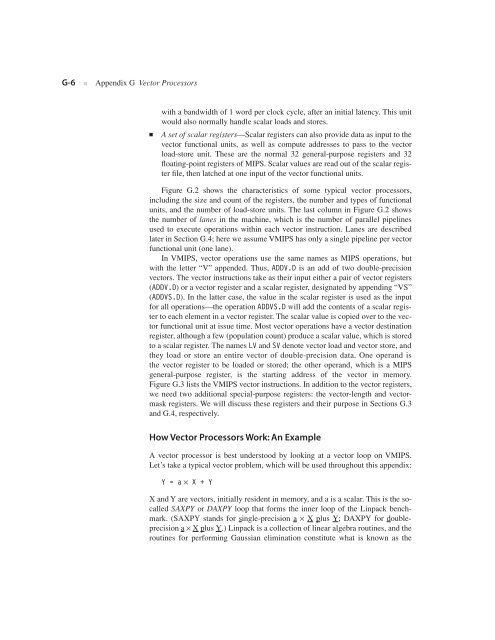Appendix G - Clemson University
Appendix G - Clemson University
Appendix G - Clemson University
Create successful ePaper yourself
Turn your PDF publications into a flip-book with our unique Google optimized e-Paper software.
G-6<br />
■<br />
<strong>Appendix</strong> G<br />
Vector Processors<br />
■<br />
with a bandwidth of 1 word per clock cycle, after an initial latency. This unit<br />
would also normally handle scalar loads and stores.<br />
A set of scalar registers—Scalar<br />
registers can also provide data as input to the<br />
vector functional units, as well as compute addresses to pass to the vector<br />
load-store unit. These are the normal 32 general-purpose registers and 32<br />
floating-point registers of MIPS. Scalar values are read out of the scalar register<br />
file, then latched at one input of the vector functional units.<br />
Figure G.2 shows the characteristics of some typical vector processors,<br />
including the size and count of the registers, the number and types of functional<br />
units, and the number of load-store units. The last column in Figure G.2 shows<br />
the number of lanes in the machine, which is the number of parallel pipelines<br />
used to execute operations within each vector instruction. Lanes are described<br />
later in Section G.4; here we assume VMIPS has only a single pipeline per vector<br />
functional unit (one lane).<br />
In VMIPS, vector operations use the same names as MIPS operations, but<br />
with the letter “V” appended. Thus, ADDV.D is an add of two double-precision<br />
vectors. The vector instructions take as their input either a pair of vector registers<br />
(ADDV.D) or a vector register and a scalar register, designated by appending “VS”<br />
(ADDVS.D). In the latter case, the value in the scalar register is used as the input<br />
for all operations—the operation ADDVS.D will add the contents of a scalar register<br />
to each element in a vector register. The scalar value is copied over to the vector<br />
functional unit at issue time. Most vector operations have a vector destination<br />
register, although a few (population count) produce a scalar value, which is stored<br />
to a scalar register. The names LV and SV denote vector load and vector store, and<br />
they load or store an entire vector of double-precision data. One operand is<br />
the vector register to be loaded or stored; the other operand, which is a MIPS<br />
general-purpose register, is the starting address of the vector in memory.<br />
Figure G.3 lists the VMIPS vector instructions. In addition to the vector registers,<br />
we need two additional special-purpose registers: the vector-length and vectormask<br />
registers. We will discuss these registers and their purpose in Sections G.3<br />
and G.4, respectively.<br />
How Vector Processors Work: An Example<br />
A vector processor is best understood by looking at a vector loop on VMIPS.<br />
Let’s take a typical vector problem, which will be used throughout this appendix:<br />
Y = a ×<br />
X + Y<br />
X and Y are vectors, initially resident in memory, and a is a scalar. This is the socalled<br />
SAXPY or DAXPY loop that forms the inner loop of the Linpack benchmark.<br />
(SAXPY stands for single-precision a × X plus Y; DAXPY for doubleprecision<br />
a × X plus Y.) Linpack is a collection of linear algebra routines, and the<br />
routines for performing Gaussian elimination constitute what is known as the

















